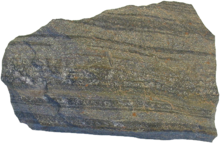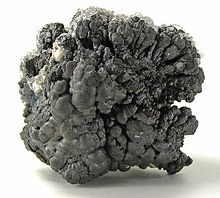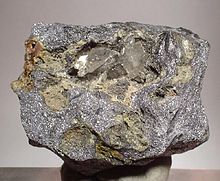
Back خام Arabic Filiz Azerbaijani Мәғдән Bashkir Rūdė BAT-SMG Руда Byelorussian Руда (карысныя выкапні) BE-X-OLD Руда Bulgarian আকরিক Bengali/Bangla Ruda BS Mena Catalan



Ore is natural rock or sediment that contains one or more valuable minerals concentrated above background levels, typically containing metals, that can be mined, treated and sold at a profit.[1][2][3] The grade of ore refers to the concentration of the desired material it contains. The value of the metals or minerals a rock contains must be weighed against the cost of extraction to determine whether it is of sufficiently high grade to be worth mining and is therefore considered an ore.[4] A complex ore is one containing more than one valuable mineral.[5]
Minerals of interest are generally oxides, sulfides, silicates, or native metals such as copper or gold.[5] Ore bodies are formed by a variety of geological processes generally referred to as ore genesis and can be classified based on their deposit type. Ore is extracted from the earth through mining and treated or refined, often via smelting, to extract the valuable metals or minerals.[4] Some ores, depending on their composition, may pose threats to health or surrounding ecosystems.
The word ore is of Anglo-Saxon origin, meaning lump of metal.[6]
- ^ Jenkin, Gawen R. T.; Lusty, Paul A. J.; McDonald, Iain; Smith, Martin P.; Boyce, Adrian J.; Wilkinson, Jamie J. (2014). "Ore deposits in an evolving Earth: an introduction". Geological Society. 393 (1): 1–8. doi:10.1144/sp393.14. ISSN 0305-8719. S2CID 129135737.
- ^ "Ore". Encyclopædia Britannica. Retrieved 2021-04-07.
- ^ Neuendorf, K.K.E.; Mehl, J.P. Jr.; Jackson, J.A., eds. (2011). Glossary of Geology. American Geological Institute. p. 799.
- ^ a b Hustrulid, William A.; Kuchta, Mark; Martin, Randall K. (2013). Open Pit Mine Planning and Design. Boca Raton, Florida: CRC Press. p. 1. ISBN 978-1-4822-2117-6. Retrieved 5 May 2020.
- ^ a b Wills, B. A. (2015). Wills' mineral processing technology : an introduction to the practical aspects of ore treatment and mineral recovery (8th ed.). Oxford: Elsevier Science & Technology. ISBN 978-0-08-097054-7. OCLC 920545608.
- ^ Rapp, George (2009), "Metals and Related Minerals and Ores", Archaeomineralogy, Natural Science in Archaeology, Berlin, Heidelberg: Springer Berlin Heidelberg, pp. 143–182, doi:10.1007/978-3-540-78594-1_7, ISBN 978-3-540-78593-4, retrieved 2023-03-06
© MMXXIII Rich X Search. We shall prevail. All rights reserved. Rich X Search